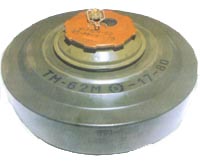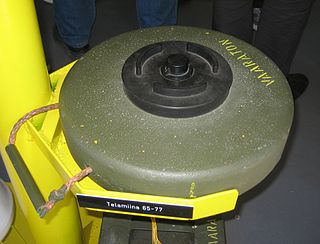Type 72 Non-Metallic is a Chinese circular, plastic bodied landmine which is designed to damage or destroy a vehicle by blast effect.

The Tellermine 42 (T.Mi.42) was a German metal-cased anti-tank blast mine used during the Second World War. The mine was a development of the Tellermine 35 with improved resistance to blast. It was followed by the simplified Tellermine 43.

The Tellermine 43 was a German circular steel cased anti-tank blast mine used during the Second World War. It was a simplified version of the Tellermine 42, which enabled simpler production techniques. Between March 1943 and the end of World War II, over 3.6 million Tellermine 43s were produced by Germany. Copies of the mine were produced by several countries including Denmark (M/47), France and Yugoslavia (TMM-1).

The TM-46 mine is a large, circular, metal-cased Soviet anti-tank mine. It uses either a pressure fuze or tilt-rod, which is screwed into the top. Anti-tank mines with this type of fuze were capable of inflicting much more damage to armored vehicles. The TMN-46 is a variant of the mine fitted with a secondary fuze well on the bottom which is slightly off-set from the centre of the mine. This secondary fuze well can be fitted with a pull-fuze which functions as an anti-handling device. The mine was used by the North Vietnamese forces during the Vietnam War, and is found in many countries in Africa, the Middle East and South East Asia.

The M15 mine is a large circular United States anti-tank blast mine, first used during World War Two. Essentially, it is a larger version of the M6A2 anti-tank mine, which it replaced. Although the M15 has been superseded by the M19 mine, the U.S. retains large stocks of M15s because they are still regarded as reliable and effective weapons. When used against main battle tanks the M15 is primarily a "track-breaker" which creates mobility kills, but has a comparatively small likelihood of causing crew fatalities. However, when used against lighter vehicles such as APCs or unarmored vehicles such as trucks the damage inflicted is much more severe.
The M7 is a small, metal-cased United States anti-tank blast mine that was used during the Second World War. It was based on the British Hawkins grenade. Approximately 2.5 million were produced before production ceased, and although it has long since been withdrawn from U.S. service, it can be found in Angola, Burma, Cambodia, Chad, Eritrea, Ethiopia, Korea, Lebanon, Myanmar, Somalia, Thailand, and Zambia.

The M19 is a large square plastic cased United States anti-tank blast mine. Intended to replace the M15 mine, the design dates from the mid-1960s and contains only two metal components: the copper detonator capsule and a stainless steel firing pin which weighs 2.86 grams. It is a minimum metal mine, which makes it very difficult to detect after it has been emplaced. This mine is produced under licence in Chile, South Korea and Turkey. A copy is produced in Iran. It is found in Afghanistan, Angola, Chad, Chile, Cyprus, Iran, Iraq, Jordan, South Korea, Lebanon, the Western Sahara, and Zambia.

TM-62 is the designation for a series of Soviet anti-tank blast mines. The mines have a central fuze and typically have a 7.5 kg explosive charge, however they vary greatly in detail. The mines can be laid manually or automatically from a mine laying machine including the PMR-1, PMR-2 wheeled towed mine layers, the GMZ tracked mine laying vehicle and the VMR-2 helicopter mine laying system.
The AT-8 or Cuban anti-tank mine is a square green plastic cased anti-tank mine. It is a scaled-up version of the Cuban anti-personnel mine. The mine consists of a plastic ribbed hinged upper case which rests on the fuzes placed into the lower plastic case. When enough pressure is placed on the upper lid the strikers are released from the fuzes. This triggers the main charge, which consists of up to twenty 400 g blocks of TNT. The mine is fitted with MUV or RO-1 type fuzes.
The SACI is an Italian Bakelite cased minimum metal anti-tank blast landmine. A number of variants were produced with varying amounts of explosive. The mine has three fuze wells on the top surface, that are covered with a pressure plate. Several types of fuzes were made including a low metal fuze. Combined with the low metal fuze the mine is very difficult to detect with mine detectors.
The SB-81 is an Italian plastic cased minimum metal anti-tank blast mine dating from the early 1980s. The mine uses an air pressure based fuze, which gives it protection against overpressure and blast. It can therefore be regarded as a blast resistant mine. The mine can be scattered by hand or by mine laying systems.

The Riegel mine 43 or is a German steel cased anti-tank bar mine used during the Second World War. The mine is a long thin rectangle. It consists of a lower and upper metal tray, and an internal metal-cased explosive block. It uses two ZZ42 fuzes inserted into either end of the internal block, although it can be used with an additional pressure fuze on the top. The mine is similar to the Italian B-2 mine. A variant, the Riegel mine 44 was also produced with a different fuze. Approximately 3,051,400 were produced between 1943 and 1945.

The M1, M1A1 and M4 are circular steel cased United States anti-tank blast mines with a distinctive cross shaped pressure spider. The mine was used during the Second World War and a copy produced in Argentina was used during the Falklands War. Another copy is produced in China. designated the No.4 mine. Variants of the mine have also been deployed in Chad and Tunisia.
The MAT-76 is a large circular Romanian minimum metal anti-tank blast mine. It is similar to the MAT-62B mine, sharing a fuze. The mine is actually a cast block of TNT with a thin coating of fibreglass. The mine has a central fuze well that normally uses a P-62 pressure fuze, although it can be used with any of the fuzes designed for the Russian TM-62 and TM-72 series of mines. The bakelite plastic used in the fuze of a MAT-76 may become brittle in desert conditions, which can reduce the activation pressure. This may make the mine unstable i.e. can detonate simply by handling it. The mine is found in Angola, Iraq, Kuwait, Liberia, Mozambique, and Zambia.

The TMA-1 and TMA-1A are circular, plastic cased Yugoslavian minimum metal anti-tank blast mine. The mine consists of an upper plastic pressure plate, and the lower body containing the main charge. The pressure plate has eight triangular raised sectors, and a central fuze cap. The pressure plate is held in place by four plastic pins, which when suffient pressure is applied, shear allowing the pressure plate to collapse onto the mine body, triggering the UANU-1 fuze. A secondary fuze well is provided in the base of the mine, allowing the use of anti-handling devices. The mine is found in Bosnia, Croatia and Kosovo.
The TMD-1 and TMD-2 are Yugoslavian wooden cased anti-tank blast mines, similar to the Russian TMD-B. The box consists of a wooden box, which contains the main cast TNT main charge. A webbing carrying handle is provided on one side of the mine. The fuze is placed in a central detonation well under the centre board of three that are fixed to the top of the mine. When sufficient pressure is placed on the boards, they collapse inwards, pressing on the installed fuze triggering the mine.
The YM-III or YM-3 is a circular ABS plastic cased Iranian minimum metal anti-tank blast mine. It is a copy of the Chinese Type 72 non-metallic anti-tank mine. The mine uses a blast-resistant fuze, which relies on gradual application of pressure to trigger it. The mine is found in Afghanistan, Bosnia, Iran, and Iraq.
The VS-AT4 and VS-AT4-EL are Italian minimum metal blast resistant anti-tank blast mines. The VS-AT4 uses a blast-resistant mechanical pressure fuze, while the VS-AT4-EL uses a programmable electronic pressure fuze with an integral anti-lifting function.

The TM 65 is a circular Finnish minimum metal anti-tank blast mine. It is broadly based on the Russian TM-62 mine. The mines body is made from a thin shell of fibreglass over a cast block of explosive, with a central fuze well that holds the pressure fuze. The original TM 65 used a US-65 fuze as used in the SM-65 anti-personnel mine, the later TM 65 77 uses a pressure fuze similar to the Russian MV-5 fuze called Painesytytin 77.
The MKT Mod 72 is an Albanian circular, metal-cased anti-tank blast mine, a copy of the Russian TM-46. Two versions of the mine are produced, the PX designated version of the mine is fitted with a secondary fuze well in the base of the mine that accepts an MUV type anti-lifting device. The mine uses a mechanical pressure fuze similar to the Russian MV-5.










